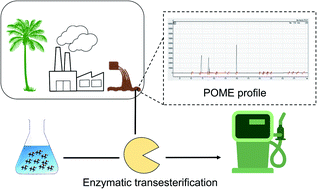当前位置:
X-MOL 学术
›
Sustain. Energy Fuels
›
论文详情
Our official English website, www.x-mol.net, welcomes your feedback! (Note: you will need to create a separate account there.)
Lipase-catalyzed ethanolysis for biodiesel production of untreated palm oil mill effluent
Sustainable Energy & Fuels ( IF 5.6 ) Pub Date : 2020/01/07 , DOI: 10.1039/c9se00457b Nova Rachmadona 1, 2, 3, 4, 5 , Jerome Amoah 3, 4, 5, 6 , Emmanuel Quayson 1, 2, 3, 4, 5 , Shinji Hama 5, 7, 8, 9 , Ayumi Yoshida 5, 7, 8, 9 , Akihiko Kondo 3, 4, 5, 6 , Chiaki Ogino 1, 2, 3, 4, 5
Sustainable Energy & Fuels ( IF 5.6 ) Pub Date : 2020/01/07 , DOI: 10.1039/c9se00457b Nova Rachmadona 1, 2, 3, 4, 5 , Jerome Amoah 3, 4, 5, 6 , Emmanuel Quayson 1, 2, 3, 4, 5 , Shinji Hama 5, 7, 8, 9 , Ayumi Yoshida 5, 7, 8, 9 , Akihiko Kondo 3, 4, 5, 6 , Chiaki Ogino 1, 2, 3, 4, 5
Affiliation

|
Palm oil mill effluent (POME), a liquid waste from the palm oil industry, presents an alternative source for biodiesel production without interfering with food supply. This study attempted to produce biodiesel from untreated POME with aqueous ethanol using Thermomyces lanuginosus lipase as a biocatalyst. The effects of enzyme concentration, alcohol to oil ratio, and ethanol concentration were considered in the transesterification reaction. The optimum conditions were 2100 U lipase loading, 4 : 1 ethanol to oil molar ratio, and 45% (v/v) ethanol concentration at 40 °C reaction, and under 24 hours. The maximum fatty acid ethyl ester (FAEE) yield reached 97.43% (w/w) under these conditions. Integration of dilute ethanol for the conversion of POME to biodiesel could be promising as both feedstocks could be obtained from the same location, and thus reduce the logistical burden on biodiesel production.
中文翻译:

脂肪酶催化的乙醇分解用于未经处理的棕榈油厂废水的生物柴油生产
棕榈油厂的废液(POME)是来自棕榈油行业的一种液体废物,是生物柴油生产的另一种来源,而不会干扰食品的供应。这项研究试图使用羊毛嗜热霉菌从未经处理的POME与乙醇水溶液生产生物柴油脂肪酶作为生物催化剂。在酯交换反应中考虑了酶浓度,醇/油比和乙醇浓度的影响。最佳条件是2100 U脂肪酶的上样量,4:1的乙醇与油的摩尔比以及在40°C反应和24小时的乙醇浓度为45%(v / v)。在这些条件下,最大脂肪酸乙酯(FAEE)的产率达到97.43%(w / w)。整合稀乙醇用于将POME转化为生物柴油的前景广阔,因为两种原料均可从同一地点获得,从而减轻了生物柴油生产的后勤负担。
更新日期:2020-03-03
中文翻译:

脂肪酶催化的乙醇分解用于未经处理的棕榈油厂废水的生物柴油生产
棕榈油厂的废液(POME)是来自棕榈油行业的一种液体废物,是生物柴油生产的另一种来源,而不会干扰食品的供应。这项研究试图使用羊毛嗜热霉菌从未经处理的POME与乙醇水溶液生产生物柴油脂肪酶作为生物催化剂。在酯交换反应中考虑了酶浓度,醇/油比和乙醇浓度的影响。最佳条件是2100 U脂肪酶的上样量,4:1的乙醇与油的摩尔比以及在40°C反应和24小时的乙醇浓度为45%(v / v)。在这些条件下,最大脂肪酸乙酯(FAEE)的产率达到97.43%(w / w)。整合稀乙醇用于将POME转化为生物柴油的前景广阔,因为两种原料均可从同一地点获得,从而减轻了生物柴油生产的后勤负担。

























 京公网安备 11010802027423号
京公网安备 11010802027423号